|
|
|
|
|
|
|
|
|
|
|
|
|
|
|
|
|
|
|
|
|
|
Some
Other Makes |
|
|
|
|
|
|
|
|
|
|
|
|
Why on earth would
anyone want to buy any other make of exposure meter when there is a Weston
available? Here you'll find some of the best and worst meters together
with a little on their strengths and weaknesses. The fact that some of
these makes are still around in the digital age must mean that they had
something and this is best summed up by Cds and Flash. Weston only twice
ventured into Cds meters with the excellent Ranger 9 but only in the US,
and the XM-2 Sekonic-made model. Cds meters use a battery and a cadmium
disulphide (disulfide in the US) cell which gives much greater sensitivity
in very low light - as in the well-named Lunasix. Other manufacturers
including Sekonic went into flash meters but Weston never went this way. |
|
|
|
|
|
|
|
|
|
|
|
|
The
beautifully made and designed Norwood Director first appeared in the late
1940's, and it has continued in production under the names of Brockway,
Sekonic Brockway and now just Sekonic. It was the favourite of Hollywood
Directors of Photography - an area where the Weston never really gained
a foothold. It's strength is the built-in incident light cone which faces
towards the operator so it can be held up to the subject and the light intensity
read off. To do this with the Weston means turning the meter dial away from
the operator. In fact the Norwood's cone can be swivelled through nearly
360 degrees making it very convenient to use where detailled incident light
readings over many parts of the set are required - something DPs often need.
Even though the Weston is technically more accurate especially in back-lit
situations, it is too awkward to use in this situation. The meter was considerably
more expensive that the Weston and so was little used by amateurs. It came
with a slide which adjusted the sensitivity of the reading, a blank slide
and two circular disks to replace the incident cone, to allow reflected
light readings to be made. The Director shown in this picture, serial no
46862, is in beautiful condition although the cone is a little yellow now.
It was, unlike later Japanese made models, manufactured in the USA by the
American Bolex Company (yes, they really were called that - the O was pronounced
as in oh fortunately). That company mainly manufactured high-end 16mm cine
cameras. Do visit John Desq's beautifully produced information
about these meters. |
|
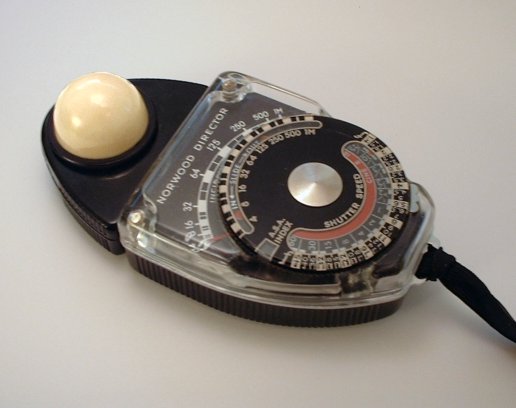 |
|
|
|
|
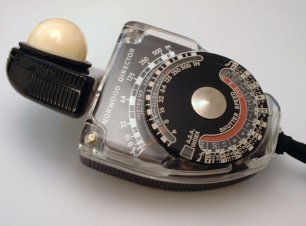 |
|
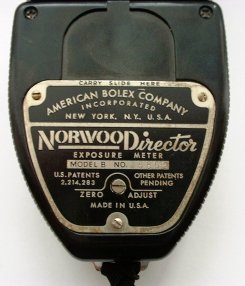 |
|
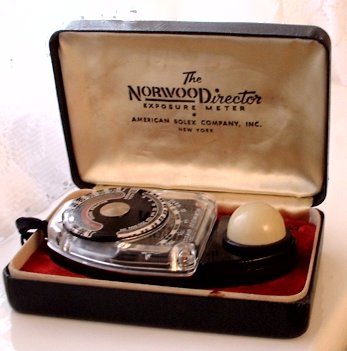 |
|
|
|
|
|
|
|
|
This little Hanimex
Sekonic "Leader De Luxe" was made in Sydney, Australia and was
a popular low-cost meter for the amateur market in the 1960s. In came complete
with a clip-on incident light plate and a plug-in extra-large photocell
for low-light work. It still works fine. In the US they cost USD8.45. A
booster cell for low light work cost a further USD 3.50 |
|
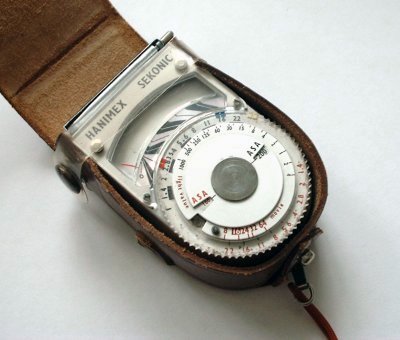 |
|
Russia
has produced meters under the Leningrad name for as long as anyone can bother
to remember. The model 4 shown dates from 1979 (21st Feb to be precise)
and for all it's lack of elegance and clumsy thick leather case, it does
actually still work well. Typical of it's bad design is that there is no
lock for the film speed setting so it's very easy to change it by mistake. |
|
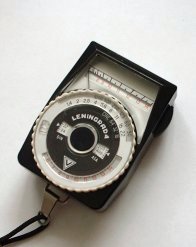 |
|
|
|
|
|
|
|
|
|

This little AVO meter
produced in the UK in the 1930s warrants a page to itself. |
|
|
|
The Lunasix has been
around since the 1960s and has been continuously developed since then.
It's boast that it could accurately measure in moonlight made it an instant
success with photographers who were starting to explore the possibilities
of fast films such as Ilford's HPS and Kodak's Royal X Pan in their mechanical
Nikons with f1.4 lenses. Weston ignored this market in the UK, except
for the Japanese made XM2, to their cost.
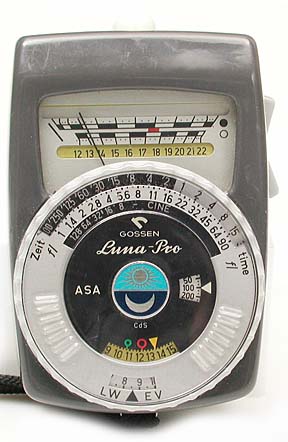
|
|
|
The
Watkins Bee is the predecessor of the electric exposure meter. It was made
around 1921 by Watkins Meter Company of Hereford and works by inserting
a piece of sensitive paper and exposing the meter to the light. The photographer
then counted off the seconds until the paper darkened to a given tone. The
time this took was translated into an exposure time using the numbers engraved
on the device. It cost five shillings then and one can be had from Ebay
for a few pounds. The instruction book - 12th Edition - which was 3 pence
extra and is an absolute delight, is reproduced here,
along with the Watkins speed list. |
|
 |
|
|
HOME |
The Gossen Sixtry
of the 1960s was West German made and designed for the amateur market.
It used a white plasic "roller shutter" to protect the dial
but if partially opened, it acted as an incident light device. The colourfull
instruction book is here. |
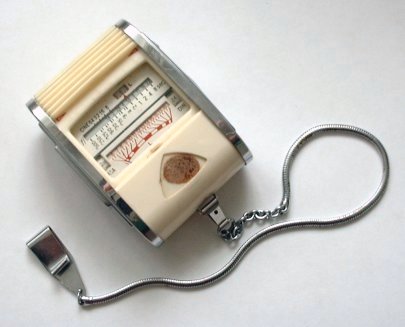 |
|
|
Looking for even more? Take a look at James Ollinger's huge collection here. |
|
|
|
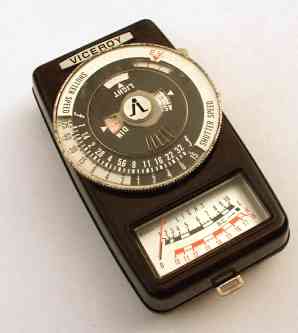 |
|
Made in Japan and no great
design icon, the Viceroy was a cds meter with a high and low scale. A poor
man's Luna-pro perhaps but very practical in low light situations.
The
meter had a sliding translucent dome for incident readings.
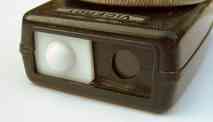
|
|
 |
 |
 |
 |
 |
 |
 |
 |
 |
 |
 |
 |
 |
 |
 |
 |
 |
 |
 |
 |
 |











